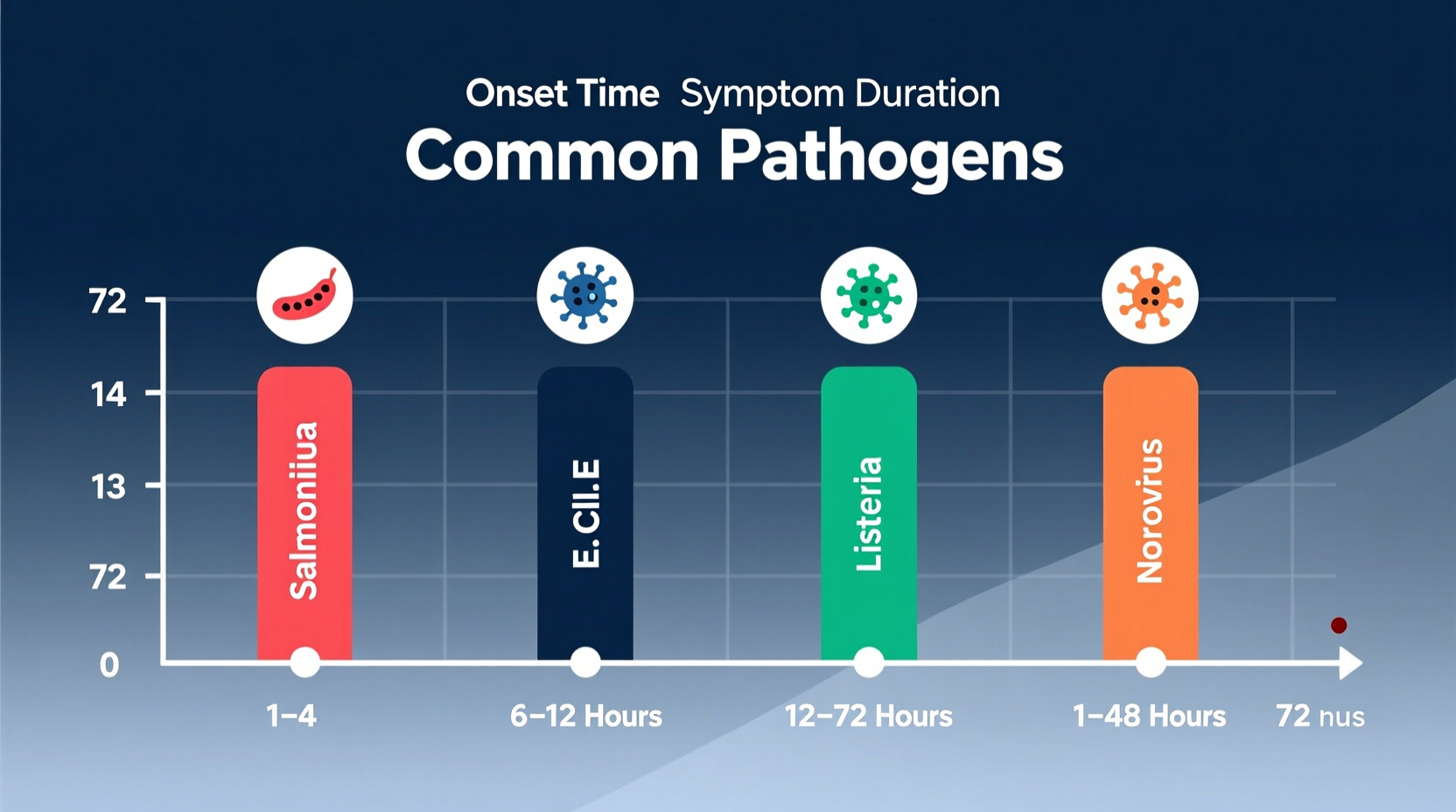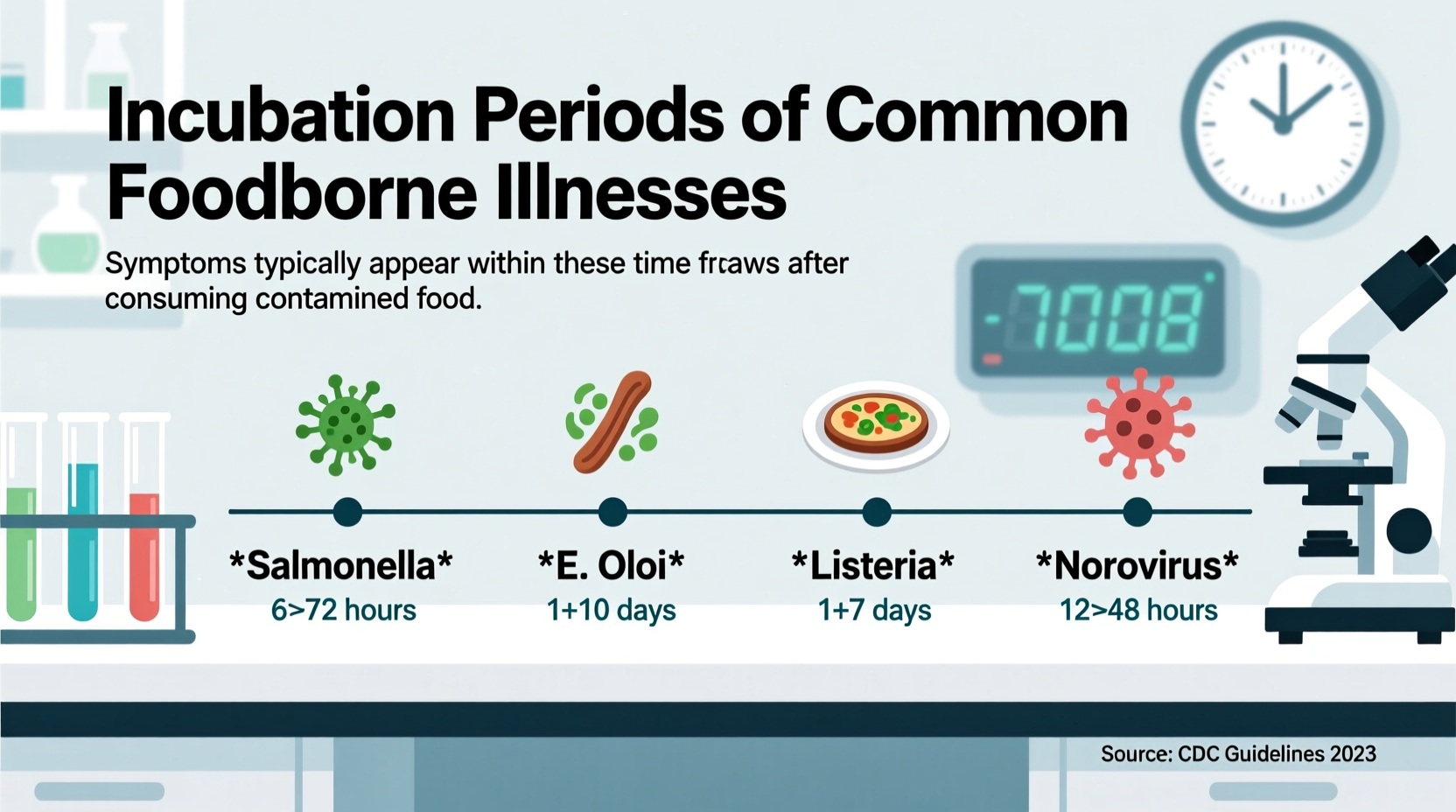Understanding when food poisoning symptoms might appear is crucial for identifying the source and determining appropriate care. This guide provides medically accurate information about symptom onset times based on the latest research from food safety authorities.
Why Food Poisoning Timing Varies
The time between consuming contaminated food and experiencing symptoms—known as the incubation period—depends primarily on the specific pathogen responsible. Different bacteria, viruses, and toxins multiply at varying rates in your digestive system before causing noticeable illness.
| Pathogen | Typical Onset Time | Common Sources | Duration |
|---|---|---|---|
| Staphylococcus aureus | 30 minutes - 8 hours | Deli meats, salads, pastries | 1-2 days |
| Bacillus cereus (vomiting type) | 1-6 hours | Fried rice, pasta | 6-24 hours |
| Norovirus | 12-48 hours | Raw shellfish, contaminated water | 1-3 days |
| Salmonella | 6 hours - 6 days | Raw eggs, poultry, produce | 4-7 days |
| E. coli (STEC) | 1-10 days (avg 3-4) | Undercooked beef, raw milk | 5-10 days |
| Listeria | 1-4 weeks | Soft cheeses, deli meats | Variable |
This comparison table, verified with data from the Centers for Disease Control and Prevention, shows why pinpointing the exact cause requires considering both symptom timing and food history. For instance, if you develop vomiting within two hours of eating, Staphylococcus or Bacillus cereus are more likely culprits than pathogens with longer incubation periods.

Factors That Influence Symptom Onset
Several variables affect how quickly food poisoning symptoms appear after consuming contaminated food:
- Pathogen concentration - Higher amounts of bacteria or virus typically lead to faster symptom development
- Individual health status - People with compromised immune systems often experience symptoms sooner
- Age factors - Infants and elderly individuals may show symptoms more rapidly
- Stomach acidity - Medications that reduce stomach acid can shorten incubation periods
- Food composition - Fatty foods may delay symptom onset by slowing stomach emptying
According to the FDA Food Code, these contextual factors explain why two people eating the same contaminated meal might develop symptoms at different times. The pathogen's virulence and the individual's gut microbiome also play significant roles in determining symptom onset.
What Happens During the Incubation Period
While you may feel fine immediately after eating contaminated food, several biological processes are occurring:
- Ingestion - Pathogens enter your digestive system through contaminated food or drink
- Survival - Microorganisms withstand stomach acid to reach the intestines
- Colonization - Bacteria multiply or viruses replicate in the intestinal tract
- Toxin production - Many pathogens release toxins that irritate the gut lining
- Symptom onset - When enough damage occurs or toxins accumulate, symptoms begin
This biological timeline explains why symptoms don't appear immediately. The CDC notes that foodborne illness symptoms typically emerge once the pathogen has multiplied sufficiently to overwhelm your body's defenses.
When to Seek Medical Attention
While most food poisoning cases resolve without treatment, certain symptoms require immediate medical care:
- Signs of severe dehydration (extreme thirst, dry mouth, little or no urination)
- Bloody stools or vomit
- Fever above 102°F (38.9°C)
- Symptoms lasting more than 3 days
- Neurological symptoms like blurred vision or muscle weakness
- Difficulty breathing or swallowing
High-risk groups including pregnant women, infants, elderly individuals, and those with compromised immune systems should consult a healthcare provider at the first sign of food poisoning. The Mayo Clinic emphasizes that prompt medical attention can prevent complications from severe cases.
Preventing Food Poisoning
Understanding symptom timing helps identify contaminated foods, but prevention remains the best strategy:
- Follow the 2-hour rule: Refrigerate perishable foods within 2 hours (1 hour if above 90°F)
- Cook foods to proper internal temperatures (poultry to 165°F, ground meats to 160°F)
- Wash hands thoroughly before handling food and after using the bathroom
- Prevent cross-contamination between raw and ready-to-eat foods
- Be cautious with high-risk foods like raw shellfish, unpasteurized dairy, and undercooked eggs
The FDA's Food Safety Education materials provide detailed guidance on safe food handling practices that significantly reduce your risk of foodborne illness.
Recovering from Food Poisoning
When symptoms do occur, proper management can shorten recovery time:
- Stay hydrated with clear fluids, oral rehydration solutions, or electrolyte drinks
- Avoid solid foods until vomiting subsides, then start with bland foods like toast and rice
- Rest to allow your body to focus energy on recovery
- Don't take anti-diarrheal medications unless recommended by a healthcare provider
- Monitor symptoms and seek medical care if warning signs develop
Most healthy adults recover from common foodborne illnesses within 1-3 days with proper self-care. However, certain pathogens like E. coli O157:H7 can cause serious complications even after initial symptoms improve.











 浙公网安备
33010002000092号
浙公网安备
33010002000092号 浙B2-20120091-4
浙B2-20120091-4